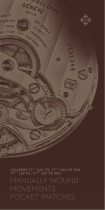Patek Philippe 5950 Mode d'emploi
- Catégorie
- Montres
- Taper
- Mode d'emploi

English
Français
Deutsch

English

Reference 5950
Caliber CHR 27-525 PS
Ultra-thin manually wound wristwatch
with monopusher rattrapante chronograph.
The manually wound caliber CHR 27-525 PS is the
world’s thinnest monopusher split seconds chro-
nograph. It unites Geneva’s grand watchmaking
heritage with 21st-century technology.
The highly complex movement, crafted one by
one to artisanal perfection, is cased in cushion-
shaped rose gold with a retro-modern design
inspired by the first 1920s Patek Philippe wrist
chronographs.

Haute horlogerie at its very finest
Patek Philippe’s caliber CHR 27-525 PS is the
world’s thinnest monopusher rattrapante chro-
nograph with column wheel control. Its height:
5.25 mm. Not least, this accomplishment is due to
the ingenious design of the continuously running
60-minute counter. Its innovative configuration is
responsible for the slimmer silhouette and at the
same time, it equalizes the torque differences be-
tween the running and stopped states of the chro-
nograph. The three chronograph wheels (driving,
clutch, and seconds wheels) are another exclusive
feature of the caliber CHR 27-525 PS movement.
Their novel patented toothing geometries reduce
wear and optimize power transmission within the
chronograph mechanism.
The pinnacle of artisanship
The caliber CHR 27-525 PS is a classic split sec-
onds chronograph construction with two column
wheels that, as always in Patek Philippe timepieces,
are crowned with polished caps. The bridges à
l’ancienne are meticulously finished with polished
chamfers and Geneva striping. Every caliber is in-
dividually hand-crafted by master watchmakers in
the Haute Horlogerie workshops. Each component is
individually filed, chamfered, polished, adjusted,
and finished. Then, the watchmaker performs the
so-called repassage en blanc – a trial assembly pro-
cedure – to carefully check all functions. After-
wards, the entire movement is taken apart again,
cleaned, reassembled, lubricated, and adjusted.
These ancestral production methods result in horo-
logical masterpieces that exceed the expectations of
even the most discerning connoisseurs.

Rattrapante hand pusher
Winding crown
Position 1: to wind the watch
Position 2: to set the time
Subsidiary seconds
Chronograph hand Chronograph pusher
60-minute counter
12
Rattrapante hand
Instructions
WINDING CROWN
The winding crown is used to wind the watch
(position 1) and to set the time (position 2)
MANUALLY WOUND
Your watch has a manually wound movement.
When fully wound, it has a power reserve of at
least 48 hours. We recommend that you wind
your watch each day at about the same time,
preferably in the morning (about 25 clockwise
turns of the crown).
Caution: Please wind the watch before you put it on. This
way, you can avoid lateral pressure on the winding stem
which in the course of the years could damage the stem
tube. Turn the crown gently and uniformly and stop as soon
as you feel resistance; if you wind the watch too vigorously,
this might damage the movement.
SETTING THE TIME
To set the time, pull the crown out, and turn it
in either direction. Once the correct time is set,
press the crown home again. The movement has a
stop-seconds mechanism (balance wheel blocker)
that allows the watch to be synchronized with
a time signal to an accuracy of one second. The
seconds hand stops when the winding crown is
pulled. It starts running again as soon as you push
the crown home again.
Caution: Please set the time only when the chronograph
is stopped and the chronograph and rattrapante hands both
return to zero, and preferably – to prevent lateral pressure
on the winding stem – before you put the watch on. We
recommend that you turn the crown only with two fingers
and use your fingernails to pull it out.

CHRONOGRAPH
The Patek Philippe rattrapante chronograph al-
lows you to measure the duration of events,
record lap times. These measurements are per-
formed with the two large sweep stop hands – the
chronograph and rattrapante hands – and with
the small 60-minute counter at 3 o’clock. Unlike
most split seconds chronographs, the Ref. 5950
is a three-phase chronograph that requires only
two pushers.
Actuating the pusher in the winding crown se-
quentially activates the three following com-
mands:
1. Simultaneously start the chronograph and
rattrapante hands,
2. Simultaneously stop the chronograph and
rattrapante hands,
3. Reset the chronograph and rattrapante hands.
Note: To avoid chronograph start problems, we recom-
mend that you postpone the use of the chronograph for 2
minutes after having set the time.
The pusher at 2 o’clock controls only the rattrapante hand.
MEASURING DURATIONS AND STOPPING LAP TIMES
When the event to be timed begins, actuate the
pusher in the winding crown: The superposed
chronograph and rattrapante hands begin to run.
To measure a lap time, press the pusher at 2 o’clock:
The rattrapante hand will stop but the chronograph
hand keeps running. Now you can take a note of
the lap time. When you actuate the pusher at 2
o’clock again, the rattrapante hand will catch up
with the chronograph hand and both hands, now
superposed, will continue running. This function
can be activated as many times as you wish. To stop
the final time, actuate the pusher in the winding
crown: this will stop the chronograph hand and
you can take a note of the duration of the event.
When you actuate the pusher in the winding crown
again, the chronograph and rattrapante hands will
both return to zero.
Caution: To reset the chronograph and rattrapante hands
to zero at the same time, they must be superposed. If the rat-
trapante hand is still indicating a lap time, actuate the pusher
at 2 o’clock to make it catch up with the chronograph hand,
and then reset both hands to zero by actuating the pusher in
the winding crown.

CALIBER: CHR 27-525 PS, MANUALLY WOUND
DIAMETER: 27.30 MM
HEIGHT: 5.25 MM
NUMBER OF PARTS: 252
NUMBER OF JEWELS: 27
POWER RESERVE: WITH THE CHRONOGRAPH DISENGAGED:
48 HOURS MIN.
BALANCE: 2-ARM GYROMAX® WITH 8 POISING WEIGHTS
FREQUENCY: 21,600 SEMI-OSCILLATIONS/HOUR (3 HZ)
BALANCE SPRING: BREGUET
HALLMARK: PATEK PHILIPPE SEAL
Movement technical data

Care and Maintenance
WATER RESISTANCE
Your watch is fitted with different types of seals
to protect the movement against the ingress of
dust and moisture and to prevent damage if it
is immersed in water. However, if your watch
receives a blow to the crown or the crystal, its
water resistance may be impaired.
If your watch has a leather or satin strap, we
recommend that avoid exposing it to water alto-
gether.
SERVICE
We recommend that you have your watch ser-
viced every three to five years. The best way to
do this is to bring your watch to an Authorized
Patek Philippe Retailer who will be happy to for-
ward it to our workshops for you. You can then
be assured that your watch will be inspected and
overhauled by a qualified master watchmaker at
Patek Philippe headquarters in Geneva.
The watchmaker will completely disassemble the
movement and then inspect, clean, and lubri-
cate all the individual parts prior to reassembly.
All functions of the watch will also be tested in
detail and the escapement regulated if necessary.
Finally, its rate accuracy will be monitored and
precision-adjusted for a further period of two
weeks. The entire process may take several weeks
because each watch must undergo a complete
series of tests to fulfill the strict quality criteria
of Patek Philippe.
If you have any questions regarding the maintenance of
your watch, contact the Authorized Patek Philippe Retailer
nearest you or our International Customer Service depart-
ment in Geneva, or visit www.patek.com.
CHANGING THE CASE BACK
Your watch comes with a sapphire-crystal case
back as well as with an interchangeable solid-
metal back. Only our watchmakers at the Patek
Philippe workshops in Geneva are authorized to
replace this back.
PATEK PHILIPPE SEAL
The Patek Philippe Seal applies to the entire
watch, including the movement, case, dial, hands,
pushers, strap, and clasp as well as to all other
facets that contribute to the precision and aes-
thetic perfection of the timepiece. It covers the
technical, functional, and aesthetic factors, but
also rate accuracy, dependability, and customer
service quality. Additionally, it reflects the mak-
er’s know-how and all other assets needed for the
development, production, and long-term main-
tenance of an extraordinary timekeeping instru-
ment.

Français

Référence 5950
Calibre CHR 27-525 PS
Chronographe mono-poussoir
à rattrapante
La Référence 5950 est équipée du calibre CHR
27-525 PS à remontage manuel, le mouvement
de chronographe mono-poussoir à rattrapante le
plus plat du monde. Une alliance parfaite entre
grand art horloger genevois et technologie du
XXIe siècle.
Ce mouvement ultracomplexe, fabriqué à la
main et à l’unité, est abrité dans un boîtier de
forme coussin dont le style rétro-contemporain
s’inspire des premiers chronographes-bracelets
Patek Philippe des années 1920.

Un chef-d’œuvre de haute horlogerie
Avec le calibre CHR 27-525 PS, Patek Philippe a
créé le mouvement chronographe mono-poussoir
à rattrapante et roues à colonnes le plus plat jamais
réalisé: 5,25 mm d’épaisseur. Cette prouesse s’ex-
plique notamment par la construction particulière
du compteur 60 minutes «traînant» (tournant en
continu), une innovation qui permet de faire
d’une pierre deux coups en réduisant la hauteur
du mouvement, tout en disposant d’un système
de compensation des différences de couples entre
chronographe enclenché et arrêté. Autre exclu-
sivité introduite sur le calibre CHR 27-525 PS: les
trois roues du mécanisme de chronographe (roue
entraîneuse de chronographe, roue d’embrayage
et roue intermédiaire) présentent des profils de
dents brevetés permettant de réduire l’usure tout
en optimisant le fonctionnement du chronographe.
Un fleuron d’artisanat
Le calibre CHR 27-525 PS présente une construc-
tion de chronographe classique avec deux roues à
colonnes dotées, comme toujours chez Patek Phi-
lippe, de chapeaux polis. Les ponts à l’ancienne
sont soigneusement anglés, polis et ornés d’un
décor de Côtes de Genève. Chaque calibre est
fabriqué à l’unité entre les mains d’un maître
horloger au sein des ateliers de Haute Horlogerie.
Tous les composants sont un à un limés, anglés,
polis, ajustés et terminés. Les horlogers effectuent
ensuite un assemblage test appelé «repassage en
blanc» afin de contrôler toutes les fonctions, puis
l’ensemble est à nouveau entièrement démonté,
nettoyé, réassemblé, lubrifié et réglé. Ces mé-
thodes de fabrication à l’ancienne donnent
naissance à des chefs-d’œuvre dépassant toutes
les attentes des connaisseurs les plus exigeants.

Poussoir de rattrapante
Couronne de remontoir
Position 1: remontage
Position 2: mise à l’heure
Petite seconde
Aiguille de chronographe Poussoir de chronographe
Compteur 60 minutes
1 2
Aiguille de rattrapante
Mode d’emploi
COURONNE DE REMONTOIR
Le remontage (position 1) et la mise à l’heure
(position 2) s’effectuent à l’aide de la couronne
de remontoir.
REMONTAGE
Votre montre est dotée d’un mouvement à re-
montage manuel. Complètement remontée, elle
bénéficie d’une réserve de marche de minimum
48 heures. Nous vous recommandons de la
remonter tous les jours plus ou moins à la
même heure, de préférence le matin (environ
25 tours de couronne, dans le sens des aiguilles
d’une montre).
Attention: il est préférable d’effectuer ce remontage
hors du poignet pour éviter les pressions latérales qui, au fil
des ans, risqueraient d’endommager le tube de la couronne
de remontoir. Tournez la couronne doucement et réguliè-
rement, en arrêtant dès que vous sentez une résistance; un
remontage trop énergique peut endommager le mouvement.
MISE À L’HEURE
L’heure se règle en tirant doucement la couronne
et en déplaçant les aiguilles vers l’avant ou vers
l’arrière. Lorsque les aiguilles indiquent la bonne
heure, poussez la couronne dans sa position ini-
tiale (contre le boîtier). Le mouvement comporte
un système de «stop seconde» (arrêt du balancier)
qui vous permet de faire une mise à l’heure à la
seconde près. Lorsque vous tirez sur la tige de
remontoir, l’aiguille des secondes s’arrête instan-
tanément. Elle redémarre immédiatement lorsque
vous repoussez la couronne contre le boîtier après
avoir fait la mise à l’heure.
Attention: la mise à l’heure doit être effectuée exclu-
sivement avec le chronographe arrêté, les deux aiguilles
de chronographe et de rattrapante remises à zéro, et de
préférence hors du poignet, afin d’éviter les pressions laté-
rales sur le tube de la couronne. Nous vous recommandons
de n’utiliser que deux doigts et de faire levier avec l’ongle
pour tirer la couronne.

CHRONOGRAPHE
Le chronographe à rattrapante Patek Philippe
vous permet de chronométrer des événements,
de mesurer des temps intermédiaires. Il possède
pour cela deux grandes aiguilles des secondes au
centre du cadran – l’aiguille de chronographe et
l’aiguille de rattrapante – ainsi qu’une aiguille des
minutes sur un petit compteur 60 minutes à 3h.
Contrairement à la plupart des chronographes à
rattrapante, la référence 5950 Patek Philippe est
ce qu’on appelle un «chronographe trois temps»,
qui ne nécessite que deux poussoirs.
En appuyant sur le poussoir logé dans la couronne,
on active successivement les trois fonctions sui-
vantes:
1. démarrage simultané des aiguilles de chrono-
graphe et de rattrapante,
2. arrêt simultané des aiguilles de chronographe
et de rattrapante,
3. remise à zéro des aiguilles de chronographe
et de rattrapante.
Attention : pour éviter tout problème de démarrage
du chronographe, il est recommandé d’attendre 2 minutes
après une mise à l’heure avant d’enclencher le chrono-
graphe.
Le poussoir à 2h sert exclusivement aux commandes de
l’aiguille de rattrapante.
MESURE D’UN TEMPS INTERMÉDIAIRE
Pour lancer le chronométrage, pressez sur le
poussoir logé dans la couronne: l’aiguille de chro-
nographe et l’aiguille de rattrapante, superposées,
se mettent en marche. Pour mesurer un temps in-
termédiaire, pressez sur le poussoir à 2h: l’aiguille
de rattrapante s’immobilise, tandis que l’aiguille
de chronographe poursuit sa course. Vous pouvez
maintenant lire le temps intermédiaire. Si vous
pressez à nouveau sur le poussoir à 2h, l’aiguille
de rattrapante rejoint instantanément l’aiguille
de chronographe et les deux aiguilles poursuivent
leur course en parfaite synchronisation. Vous
pouvez répéter ce processus aussi souvent que
vous le désirez.
Pour mesurer le temps final, actionnez le poussoir
logé dans la couronne: l’aiguille de chronographe
s’arrête et vous pouvez lire le temps mesuré. Une
nouvelle pression sur le poussoir logé dans la
couronne vous permettra de remettre à zéro les
deux aiguilles de chronographe et de rattrapante.
Attention: pour pouvoir être remises à zéro ensemble,
les aiguilles de chronographe et de rattrapante doivent être
superposées. Si l’aiguille de rattrapante est encore arrêtée
sur un temps intermédiaire, commencez par lui faire «rat-
traper» l’aiguille de chronographe grâce au poussoir à 2h,
avant de remettre à zéro les deux aiguilles à l’aide du poussoir
logé dans la couronne.

CALIBRE: CHR 27-525 PS, REMONTAGE MANUEL
DIAMÈTRE: 27,30 MM
ÉPAISSEUR: 5,25 MM
NOMBRE DE COMPOSANTS: 252
NOMBRE DE RUBIS: 27
RÉSERVE DE MARCHE: AVEC LE CHRONOGRAPHE NON ENCLENCHÉ :
MIN. 48 HEURES
BALANCIER: GYROMAX® A 2 BRAS, 8 MASSELOTTES
FRÉQUENCE: 21600 ALTERNANCES PAR HEURE (3 Hz)
SPIRAL: BREGUET
SIGNE DISTINCTIF: POINÇON PATEK PHILIPPE
Caractéristiques du mouvement

Entretien
ÉTANCHÉITÉ
Votre montre est dotée de joints et fermetures
conçus pour protéger le mouvement de la pous-
sière, de l’humidité et de tout risque de détériora-
tion en cas d’immersion. Un choc sur la couronne
ou sur la glace de votre montre risque toutefois
d’en affecter l’étanchéité.
Par ailleurs, si votre montre est munie d’un bra-
celet en cuir ou en satin, nous vous suggérons
d’éviter qu’elle n’entre en contact avec l’eau.
RÉVISION
Nous vous recommandons de faire réviser votre
montre au moins une fois tous les trois à cinq ans.
Il vous suffit pour cela de la remettre à un détail-
lant ou un centre de service agréé Patek Philippe,
lequel se chargera de l’envoyer à la manufacture.
Vous aurez ainsi l’assurance qu’elle sera confiée
à un maître horloger qualifié chez Patek Philippe,
à Genève.
L’horloger démontera complètement le mouve-
ment, nettoiera tous ses composants, le vérifiera
et le lubrifiera lors du remontage. Après avoir
testé son bon fonctionnement et procédé, si né-
cessaire, au réglage de l’échappement, il gardera
encore la montre au moins deux semaines sup-
plémentaires afin de régler la marche. L’ensemble
du service peut prendre plusieurs semaines – le
temps nécessaire pour réaliser tous les tests et
contrôles permettant de répondre aux normes de
qualité Patek Philippe.
Pour toute question concernant l’entretien de votre montre,
ou pour obtenir l’adresse du centre de service agréé Patek
Philippe le plus proche, veuillez contacter notre Service
Clients International, à Genève, ou consulter notre site Inter-
net www.patek.com.
CHANGEMENT DE FOND
Votre montre a été livrée avec un fond en verre
saphir et un fond plein interchangeables. Seul un
maître horloger qualifié chez Patek Philippe, à
Genève, peut procéder au changement de fond.
POINÇON PATEK PHILIPPE
Label de qualité globale, le Poinçon Patek Phi-
lippe s’applique à l’ensemble de la montre finie,
en incluant le mouvement, le boîtier, le cadran,
les aiguilles, les poussoirs, les bracelets et les fer-
moirs, ainsi que tous les autres éléments concou-
rant à la bonne marche ou à la perfection exté-
rieure d’un garde-temps. Couvrant à la fois les
aspects techniques, fonctionnels et esthétiques,
il ne met pas seulement en valeur la bienfacture
de la montre, mais aussi sa précision et sa fiabilité,
ainsi que la qualité du service. Il intègre par là
même tous les savoir-faire et signes distinctifs liés
à la conception, à la fabrication et à l’entretien à
long terme d’un garde-temps d’exception.

Deutsch

Referenz 5950
Kaliber CHR 27-525 PS
Extraflache Armbanduhr
mit Eindrücker-Doppelchronograph
und Handaufzug.
Mit ihrem Handaufzugskaliber CHR 27-525 PS
besitzt die Referenz 5950 das flachste Eindrü-
cker-Doppelchronographenwerk der Welt, das
für die perfekte Verbindung der großen Genfer
Uhrmacherkunst mit der Technologie des 21.
Jahrhunderts steht.
Das hoch komplizierte Uhrwerk, das ausschließlich
in handwerklicher Einzelanfertigung entsteht,
tickt in einem kissenförmigen Gehäuse, dessen
retro-modernes Design sich an die ersten
Patek Philippe Armbandchronographen der 1920er
Jahre anlehnt.

Ein Meisterwerk hoher Uhrmacherkunst
Mit dem Kaliber CHR 27-525 PS hat Patek Philippe
das weltweit flachste Eindrücker-Doppelchronogra-
phenwerk mit Schaltradsteuerung geschaffen. Seine
Höhe: 5,25 mm. Möglich wurde diese Meisterleis-
tung nicht zuletzt durch die raffinierte Konstruktion
des mitlaufenden (kontinuierlich drehenden)
60-Minutenzählers. Seine innovative Auslegung
ermöglicht eine flachere Bauweise und kompensiert
gleichzeitig die Drehmomentunterschiede bei
ein- und ausgeschalteter Chronographenfunktion.
Eine weitere Exklusivität des Kalibers CHR 27-525 PS
sind die drei Chronographenräder (Chrono-Zent-
rumsrad, Kupplungsrad und Mitnehmerrad). Ihre
neuartigen patentierten Zahnprofile reduzieren die
Abnützung und optimieren die Kraftübertragung
innerhalb des Chronographenmechanismus.
Eine handwerkliche Spitzenleistung
Beim Kaliber CHR 27-525 PS handelt es sich um eine
klassische Doppelchronographen-Konstruktion
mit zwei Schalträdern, die wie immer bei Patek
Philippe polierte Hütchen tragen. Die Brücken
„à l’ancienne“ sind sorgfältig mit polierten
Anglierungen und mit Genfer Streifen versehen.
Jedes Kaliber entsteht als Einzelanfertigung
in den „Haute Horlogerie“-Ateliers unter
den Händen eines Meisteruhrmachers. Jedes
Bestandteil wird einzeln zurechtgefeilt, angliert,
poliert, eingepasst und fertig gestellt. Jetzt
nimmt der Uhrmacher eine Testmontage, die
so genannten „repassage en blanc“ vor, um jede
Funktion genau zu kontrollieren. Dann wird das
ganze Uhrwerk wieder demontiert, gereinigt
und anschließend neu zusammengesetzt, geölt
und einreguliert. Auf diese althergebrachte
Fabrikationsweise entstehen kleine Meisterwerke,
die selbst die höchsten Ansprüche ausgewiesener
Kenner übertreffen.

Drücker für den Einholzeiger
Aufzugskrone
Position 1: Aufziehen
Position 2: Zeigerstellen
Kleine Sekunde
Chronographenzeiger Chronographendrücker
60-Minuten-Zähler
1 2
Einholzeiger
Bedienungsanleitung
AUFZUGSKRONE
Das Aufziehen (Position 1) und Zeigerstellen (Po-
sition 2) erfolgt mit Hilfe der Aufzugskrone.
HANDAUFZUG
Ihre Uhr besitzt ein Uhrwerk mit Handaufzug.
Komplett aufgezogen hat sie eine Gangreserve von
mindestens 48 Stunden. Wir empfehlen Ihnen,
Ihre Uhr jeden Tag in etwa zur gleichen Zeit
aufzuziehen, mit Vorteil morgens (ca. 25 Um-
drehungen der Krone im Uhrzeigersinn).
Achtung: Ziehen Sie die Uhr auf, bevor Sie diese anlegen.
Sie vermeiden dadurch seitlichen Druck auf die Aufzugs-
welle, der im Lauf der Jahre das Aufzugsrohr in Mitleiden-
schaft ziehen könnte. Drehen Sie die Aufzugskrone sanft und
regelmäßig und hören Sie auf, sobald Sie einen Widerstand
fühlen; ein zu heftiges Aufziehen kann das Uhrwerk beschä-
digen.
EINSTELLEN DER UHRZEIT
Um die Zeiger auf die richtige Uhrzeit zu stellen,
ziehen Sie sanft die Aufzugskrone und drehen
diese vor- oder rückwärts. Sind die Zeiger auf die
richtige Uhrzeit gestellt, drücken Sie die Krone
wieder ans Gehäuse. Das Werk verfügt über einen
Sekundenstopp (Anhalten der Unruh), dank dem
die Uhrzeit mit Hilfe eines Zeitzeichens sekun-
dengenau eingestellt werden kann. Durch Zie-
hen der Aufzugskrone wird der Sekundenzeiger
gestoppt. Er setzt sich unverzüglich wieder in
Bewegung, sobald Sie nach dem Stellen der Zeiger
die Krone ans Gehäuse drücken.
Achtung: : Das Einstellen der Uhrzeit darf nur bei ge-
stopptem Chronographen erfolgen, mit der Chronographen-
und der Einholzeiger wieder auf Null gestellt und mit Vorteil,
bevor Sie die Uhr anlegen. Sie vermeiden dadurch seitlichen
Druck auf die Aufzugswelle. Wir empfehlen, die Krone nur
mit zwei Fingern zu bedienen und zum Ziehen der Krone
die Fingernägel als Hebel zu benützen.

CHRONOGRAPH
Mit dem Patek Philippe Doppelchronographen
können Sie die Dauer von Ereignissen stoppen,
Zwischenzeiten nehmen. Dazu dienen die beiden
großen Stoppzeiger aus der Mitte – der Chrono-
graphen- und der Einholzeiger – sowie der Minu-
tenzeiger im kleinen 60-Minutenzähler bei 3 Uhr.
Anders als die meisten Doppelchronographen ist
die Ref. 5950 ein Drei-Phasen-Chronograph, der
nur zwei Drücker benötigt.
Durch Betätigen des Drückers in der Aufzugs-
krone werden nacheinander die drei folgenden
Kommandos ausgelöst werden:
1. Gleichzeitiges Starten des Chronographen-
und Einholzeigers,
2. Gleichzeitiges Stoppen des Chronographen-
und Einholzeigers,
3. Nullstellen des Chronographen- und des Ein-
holzeigers.
Achtung: Um etwaige Probleme mit dem Starten des Chro-
nographen zu vermeiden, sollten Sie nach dem Einstellen der
Uhrzeit jeweils 2 Minuten warten, bevor Sie den Chronographen
auslösen.
Der Drücker bei 2 Uhr steuert ausschließlich den Einholzeiger.
ZEITMESSUNG MIT ZWISCHENZEITNAHME
Betätigen Sie bei Beginn des zu messenden
Ereignisses den Drücker in der Aufzugskrone: Der
Chronographen und der Einholzeiger setzen sich
übereinander liegend in Bewegung.
Um eine Zwischenzeit zu messen, betätigen Sie den
Drücker bei 2 Uhr: Der Einholzeiger bleibt stehen,
während der Chronographenzeiger weiterläuft.
Jetzt können Sie die Zwischenzeit ablesen. Sobald
Sie den Drücker bei 2 Uhr erneut betätigen,
holt der Einholzeiger den Chronographenzeiger
wieder ein, und beide Zeiger laufen deckungsgleich
weiter. Diesen Vorgang können Sie beliebig oft
wiederholen. Um die Endzeit zu stoppen, betätigen
Sie den Drücker in der Aufzugskrone: der Chrono-
graphenzeiger hält an, und Sie können die Endzeit
ablesen. Durch erneutes Betätigen des Drückers in
der Aufzugskrone werden der Chronographen- und
der Einholzeiger wieder auf Null gestellt.
Achtung: Um den Chronographen- und den Einholzeiger
miteinander auf Null zu stellen, müssen beide Zeiger de-
ckungsgleich übereinander liegen. Steht der Einholzeiger noch
auf einer Zwischenzeit, lassen Sie ihn durch Betätigen des
Drückers bei 2 Uhr zum Chronographenzeiger vorspringen
und stellen dann beide Zeiger mit dem Drücker in der
Aufzugskrone auf Null.
La page est en cours de chargement...
La page est en cours de chargement...
-
 1
1
-
 2
2
-
 3
3
-
 4
4
-
 5
5
-
 6
6
-
 7
7
-
 8
8
-
 9
9
-
 10
10
-
 11
11
-
 12
12
-
 13
13
-
 14
14
-
 15
15
-
 16
16
-
 17
17
-
 18
18
-
 19
19
-
 20
20
-
 21
21
-
 22
22
Patek Philippe 5950 Mode d'emploi
- Catégorie
- Montres
- Taper
- Mode d'emploi
dans d''autres langues
- English: Patek Philippe 5950 User guide
- Deutsch: Patek Philippe 5950 Benutzerhandbuch
Documents connexes
-
 Patek Philippe 5959 Mode d'emploi
Patek Philippe 5959 Mode d'emploi
-
 Patek Philippe 7059 Mode d'emploi
Patek Philippe 7059 Mode d'emploi
-
 Patek Philippe 5370 Mode d'emploi
Patek Philippe 5370 Mode d'emploi
-
 Patek Philippe 5170 Mode d'emploi
Patek Philippe 5170 Mode d'emploi
-
 Patek Philippe 5470 Mode d'emploi
Patek Philippe 5470 Mode d'emploi
-
 Patek Philippe 7968 Mode d'emploi
Patek Philippe 7968 Mode d'emploi
-
 Patek Philippe CH 28-520 IRM QA 24H Manuel utilisateur
Patek Philippe CH 28-520 IRM QA 24H Manuel utilisateur
-
 Patek Philippe 980 Mode d'emploi
Patek Philippe 980 Mode d'emploi
-
 Patek Philippe 5990 Mode d'emploi
Patek Philippe 5990 Mode d'emploi
-
 Patek Philippe 5373 Mode d'emploi
Patek Philippe 5373 Mode d'emploi































